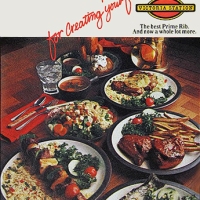 One trouble with the ideal of snowy white restaurant linens is, of course, laundry that piles up and must be washed. By the late 19th century huge steam laundries in big cities were able to handle up to 100,000 pieces a day. And about the same time a new idea in laundry service came along. Rather than owning linens a restaurant could, in effect, rent them from a service that would bring fresh supplies every time they picked up dirty laundry. Many of the first such businesses called themselves towel services, reflecting that their primary customers were factories using thousands of shop towels. Restaurants and hotels developed as the next customer base.
One trouble with the ideal of snowy white restaurant linens is, of course, laundry that piles up and must be washed. By the late 19th century huge steam laundries in big cities were able to handle up to 100,000 pieces a day. And about the same time a new idea in laundry service came along. Rather than owning linens a restaurant could, in effect, rent them from a service that would bring fresh supplies every time they picked up dirty laundry. Many of the first such businesses called themselves towel services, reflecting that their primary customers were factories using thousands of shop towels. Restaurants and hotels developed as the next customer base.
According to a book called Service Imperative, it was around World War I that the modern linen supply industry developed, with over 900 firms in the US. Most were in New York, followed by Illinois, Ohio, and Pennsylvania. At about the same time a national organization of linen supply companies was formed, the forerunner to the Linen Supply Association of America, renamed the Textile Rental Services Association of America in 1979 to better reflect the full range of member services – and to improve the organization’s public image.
It seems to me that the name change was mostly about public relations. While it may have been true that “linen supply” did not reflect all services, the difference between “textile rental” and “linen supply” is a bit subtle. Why the change? On the face of it the words “linen supply” sound completely innocent. Yet by the mid 20th century they had acquired a negative tinge thanks to mob infiltration in the business coupled with widely publicized congressional hearings, particularly the U.S. Senate’s McClellan committee which investigated organized crime in the late 1950s and early 1960s.
 Linen supply was one of a number of services to restaurants, along with garbage hauling, that attracted the mob in the 1920s and even more so in the 1930s when Prohibition ended and bootlegging profits dwindled. It offered itself as a legitimate business in which it was possible to gain dominance rapidly as well as a way for mobsters who had migrated into narcotics to launder money. In Kansas City, a mob magnet in the 1930s, gangs made handsome profits in linen supply. Running the industry as a monopoly, they reportedly divided up the city, agreed not to compete, and set prices high.
Linen supply was one of a number of services to restaurants, along with garbage hauling, that attracted the mob in the 1920s and even more so in the 1930s when Prohibition ended and bootlegging profits dwindled. It offered itself as a legitimate business in which it was possible to gain dominance rapidly as well as a way for mobsters who had migrated into narcotics to launder money. In Kansas City, a mob magnet in the 1930s, gangs made handsome profits in linen supply. Running the industry as a monopoly, they reportedly divided up the city, agreed not to compete, and set prices high.
Certainly not all linen supply companies were, or are, mob affiliated or engaged in illegal activities, yet in some places – notably NYC, Chicago, and Detroit — many have been. In 1958 New Jersey linen supply corporations charged with violation of anti-trust laws were said to control 85% of business in that state. Linen supply racketeering continues today. In 2003 the NY Times reported that the president of White Plains Coat & Apron Co., doing business with restaurants in NYC, Westchester, and parts of Connecticut and New Jersey, pled guilty to conspiring to restrain trade over a ten-year period in which sales had totaled better than $500M.
The cost of monopoly linen services does not affect consumers enough that they notice it. Restaurant owners, on the other hand, experience higher operating costs. And, as Patricia Murphy found out long ago, they are likely to be paid a visit by a “plug-ugly” if they try to switch suppliers. “I chased him out the door with a broom,” she said, adding, “I suppose I was too insignificant a client for him to carry out threats of reprisals.”
© Jan Whitaker, 2010












 It's great to hear from readers and I take time to answer queries. I can't always find what you are looking for, but I do appreciate getting thank yous no matter what the outcome.
It's great to hear from readers and I take time to answer queries. I can't always find what you are looking for, but I do appreciate getting thank yous no matter what the outcome.


